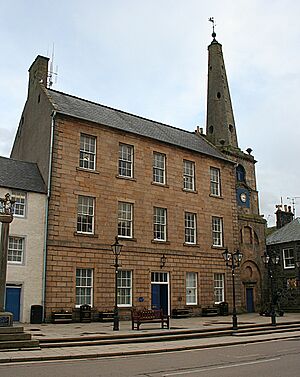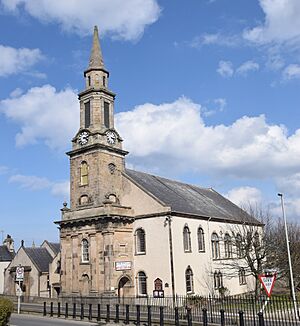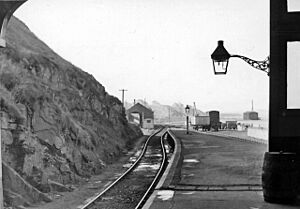Banff, Aberdeenshire facts for kids
Quick facts for kids Banff
|
|
|---|---|
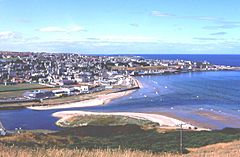 Banff |
|
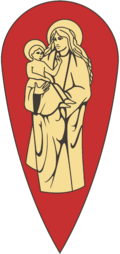 Coat of arms of Banff |
|
| Population | 4,000 (2020) |
| OS grid reference | NJ688642 |
| • Edinburgh | 121 mi (195 km) |
| • London | 436 mi (702 km) |
| Council area | |
| Lieutenancy area | |
| Country | Scotland |
| Sovereign state | United Kingdom |
| Post town | BANFF |
| Postcode district | AB45 |
| Dialling code | 01261 |
| Police | Grampian |
| Fire | Grampian |
| Ambulance | Scottish |
| EU Parliament | Scotland |
| UK Parliament |
|
| Scottish Parliament |
|
Banff (Scottish Gaelic: Banbh) is a town in Aberdeenshire, Scotland. It is located on Banff Bay and faces the town of Macduff. The River Deveron flows between them. Banff used to be a "royal burgh," which meant it had special rights from the king. It was also the main town of the historic area called Banffshire.
Contents
What Does the Name Banff Mean?
The exact meaning of the name Banff is not fully known. One idea is that it comes from the Scottish Gaelic word banbh, meaning 'piglet'. However, a more likely idea is that it comes from bean-naomh, which means 'holy woman' in Gaelic. This fits with the town's coat of arms, which shows the Virgin Mary.
A Look Back: Banff's History
Early Days and Trading
Banff's first castle was built to protect against Viking invaders. King Malcolm IV lived there around 1163. At this time, Banff was a busy trading town. It was part of a group of northern Scottish towns that traded freely. Even without its own harbour until 1775, Banff was important for trade.
In 1372, King Robert II gave Banff the special status of a Royal Burgh. This meant the town had more rights and freedoms. By the 1400s, Banff was one of the main towns in Europe that exported salmon. Other important towns for salmon trade were Aberdeen and Montrose.
Building Bridges and Roads
The River Deveron separates Banff and Macduff. This river could be wild and unpredictable. A seven-arch bridge was finished in 1779 by John Smeaton to control it. An earlier bridge built in 1765 was washed away by floods in 1768.
In 1800, people decided to build a better road between Turriff and Banff. Later in the 1800s, two railway lines were built. One connected Macduff to Turiff in 1860. The other, the Banff, Portsoy and Strathisla Railway, connected to the main Aberdeen to Inverness line in 1859.
Fishing and Language
During the 1800s, the Banff Fishery District was very important for catching herring. In 1853, they caught over 60,000 barrels of herring! Almost 34,000 barrels were sent to other countries. However, by 1912, the amount of herring caught had greatly decreased.
Today, people in Banff and nearby areas often speak the Doric dialect of Scots, as well as English.
What to See in Banff
Banff has a golf course called Duff House Royal and nice beaches. The town is also home to the COAST Festival of the Visual Arts. This festival happens every year at the end of May. It features weekend-long events and attractions in both Banff and Macduff.
Banff has many old buildings, making it one of the best-preserved towns in Scotland. You can still see parts of the old Banff Castle. There is also a market cross and a tolbooth (an old courthouse and prison). Many old townhouses and a museum, given by Andrew Carnegie, are also here.
Close by is Duff House, a beautiful classical house designed by William Adam in 1730. It is open to the public and is part of the National Gallery of Scotland. You can also visit the Wrack Woods, south of Duff House. These woods have an old ice house, a mausoleum, and a path to the quiet Bridge of Alvah. This bridge has a single arch over the River Deveron. The Deveron River is famous for its salmon and trout fishing.
Exploring Low Street
- The Town House: This building was constructed in 1797. The tall spire next to it, called the Steeple, was built earlier in 1764.
- Wilson's: Located at 57–59 Low Street, this building dates back to 1835.
- New Market Archway: A grand archway leads to the New Market. It was built in 1831 to celebrate the market moving to the town center.
- Tolbooth Hotel: This hotel at 53–55 Low Street was built in 1801. It replaced the old tolbooth building.
- Clydesdale Bank: The building at 49–57 Low Street was a Clydesdale Bank in 1837 and still is today.
- Carmelite House: At 28 Low Street, this house was built in 1753 for Admiral William Gordon.
- Bank of Scotland: The Bank of Scotland building at 29 Low Street was built in 1891.
- Fife Arms Hotel: This building, now flats, replaced an older inn to welcome visitors to Duff House.
- Court House and County Hall: At 1 Low Street, this building was constructed between 1870 and 1871. It stands where Lord Byron's grandmother used to live.
Bridge Street's Charm
Bridge Street is a long, narrow street with many 18th-century buildings. It was the main way to enter the town from the east. You can see interesting shops with cast-iron columns and old crowstepped roofs.
Institution Terrace and the Old Academy
The Old Academy (also known as Wilson's Academy, then Banff Academy) was built in 1837. It was funded by money left by James Wilson. This building housed both the school and the Museum of the Banff Institution for Science, Literature & the Arts.
Back Path's Historic Houses
Back Path is a street with charming houses. Many have "crowsteps" on their roofs. One house, number 8, has a special stone panel that says: George Malsie ... Elspet Morison ... 1739 ... God's Providence is our Inheritance.
High Street Highlights
- Banff Parish Church: This church was built in 1778. Its tower and spire were added later in 1842.
- St Andrew's Church: Built in 1833, this church is another important building.
- St Brandon's: This old town house was built around 1760.
- County Hotel: Located at 32 High Street, this hotel was built in 1770.
- Shoemakers' Land: At 43–47 High Street, this building was built in 1710 for local leather and shoe makers. It was later changed into homes and shops.
- Forbes House: A tall town house at 77–81 High Street, built in 1741.
Boyndie Street's Old Route
Boyndie Street was an ancient path leading west to Cullen. Boyndie House, at number 9, was built in 1740 and has a unique "Dutch-gable" roof. The Town & County Club town house, built in 1772, is one of the largest old town houses in this part of Scotland.
Banff Harbour and Marina
While Banff's harbour is no longer a busy commercial port, it has been updated. It now has a marina for leisure boats and small fishing boats. The marina's entrance is kept dredged, making it easier for boats to access.
Banff's Climate
Banff has an oceanic climate. This means it has mild temperatures all year round.
| Climate data for Banff (27m asl, averages 1991–2020) | |||||||||||||
|---|---|---|---|---|---|---|---|---|---|---|---|---|---|
| Month | Jan | Feb | Mar | Apr | May | Jun | Jul | Aug | Sep | Oct | Nov | Dec | Year |
| Mean daily maximum °C (°F) | 6.8 (44.2) |
7.1 (44.8) |
8.9 (48.0) |
11.1 (52.0) |
13.8 (56.8) |
15.9 (60.6) |
17.9 (64.2) |
18.0 (64.4) |
16.0 (60.8) |
12.5 (54.5) |
9.3 (48.7) |
6.9 (44.4) |
12.0 (53.6) |
| Mean daily minimum °C (°F) | 2.1 (35.8) |
2.1 (35.8) |
3.0 (37.4) |
4.7 (40.5) |
6.6 (43.9) |
9.7 (49.5) |
11.6 (52.9) |
11.7 (53.1) |
10.0 (50.0) |
7.2 (45.0) |
4.4 (39.9) |
2.2 (36.0) |
6.3 (43.3) |
| Average rainfall mm (inches) | 54.4 (2.14) |
46.5 (1.83) |
45.9 (1.81) |
50.3 (1.98) |
49.6 (1.95) |
56.4 (2.22) |
66.6 (2.62) |
64.1 (2.52) |
63.0 (2.48) |
77.4 (3.05) |
72.5 (2.85) |
65.1 (2.56) |
711.8 (28.01) |
| Average rainy days (≥ 1 mm) | 13.5 | 11.3 | 12.8 | 11.2 | 9.9 | 9.2 | 10.2 | 10.4 | 13.2 | 12.2 | 14.8 | 13.1 | 141.8 |
| Mean monthly sunshine hours | 43.3 | 67.2 | 108.0 | 145.3 | 198.4 | 150.5 | 147.4 | 149.7 | 112.1 | 85.6 | 52.8 | 28.7 | 1,289 |
| Source: Met Office (rain days 1981–2010) | |||||||||||||
Railways in Banff
Banff was once served by two railway lines. The Banff, Portsoy and Strathisla Railway (BPSR) started in 1857. The Banff, Macduff and Turriff Junction Railway began in 1860. This second line was part of the Great North of Scotland Railway (GNSR).
Later, the GNSR took over the older BPSR line. In 1872, new stations were built closer to Macduff. Banff Bridge station opened near the bridge between Banff and Macduff. The original Banff & Macduff station then closed.
However, many railway lines were closed in the mid-1900s. Banff Bridge station closed by the end of 1951. Banff Harbour station (later just called Banff) closed in 1964. Today, the closest open train stations are Huntly and Keith, about 20 miles away.
Sports in Banff
Banff and the surrounding areas have several sports teams.
- Deveronvale F.C. is a local Highland League football team.
- Deveronside F.C. is a Junior football club.
- Banff RFC is the local rugby team.
The Duff House Royal Golf Club course is next to the River Deveron and Duff House. The town also has sports pitches at Canal Park.
Famous People from Banff
Many notable people have connections to Banff:
- Thomas Ruddiman (1674–1757), a scholar and publisher.
- Walter Ruddiman (1719–1781), a printer and newspaper owner.
- George Duff (1764–1805), a British naval officer.
- James Milne Wilson (1812–1880), who became the Premier of Tasmania.
- Thomas Edward (1814–1886), a naturalist who studied nature.
- William Brodie (1815–1881), a sculptor.
- Margaret Catherine Blaikie (1823–1915), a Scottish reformer.
- William Bankier (1870–1949), a famous bodybuilder and strongman.
- Richard Gordon (1947–2009), an author.
- Sandi Thom (born 1981), a singer-songwriter.
- James McManus (born 1986), a rugby league player.
- Bruce Anderson (born 1998), a football player.
See also
 In Spanish: Banff (Aberdeenshire) para niños
In Spanish: Banff (Aberdeenshire) para niños



